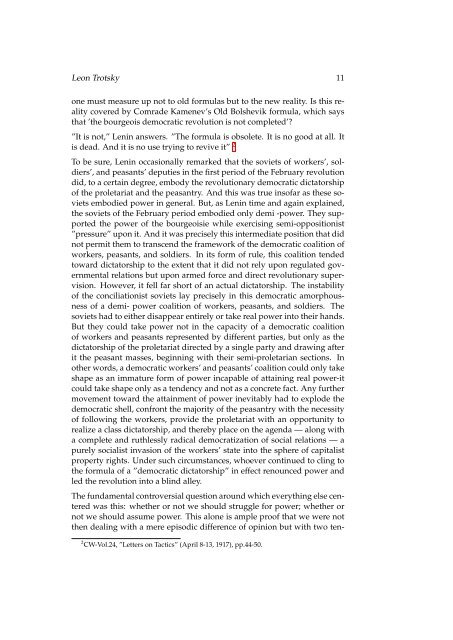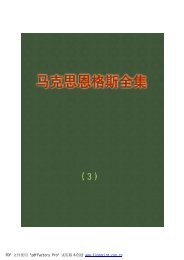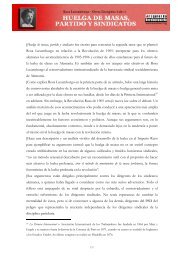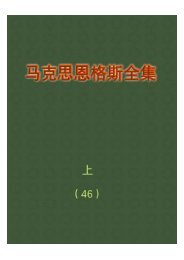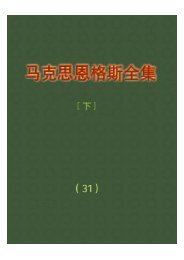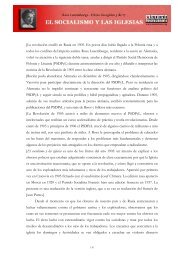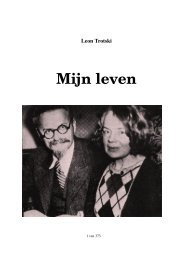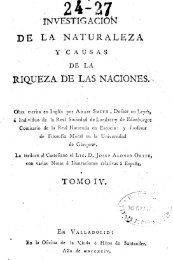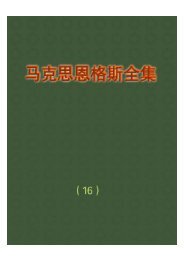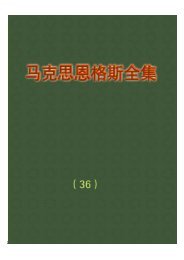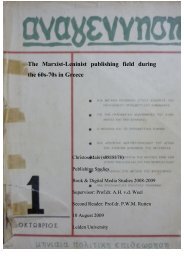Leon Trotsky, The Lessons of October - Platypus
Leon Trotsky, The Lessons of October - Platypus
Leon Trotsky, The Lessons of October - Platypus
You also want an ePaper? Increase the reach of your titles
YUMPU automatically turns print PDFs into web optimized ePapers that Google loves.
<strong>Leon</strong> <strong>Trotsky</strong> 11one must measure up not to old formulas but to the new reality. Is this realitycovered by Comrade Kamenev’s Old Bolshevik formula, which saysthat ’the bourgeois democratic revolution is not completed’?”It is not,” Lenin answers. ”<strong>The</strong> formula is obsolete. It is no good at all. Itis dead. And it is no use trying to revive it” 2To be sure, Lenin occasionally remarked that the soviets <strong>of</strong> workers’, soldiers’,and peasants’ deputies in the first period <strong>of</strong> the February revolutiondid, to a certain degree, embody the revolutionary democratic dictatorship<strong>of</strong> the proletariat and the peasantry. And this was true ins<strong>of</strong>ar as these sovietsembodied power in general. But, as Lenin time and again explained,the soviets <strong>of</strong> the February period embodied only demi -power. <strong>The</strong>y supportedthe power <strong>of</strong> the bourgeoisie while exercising semi-oppositionist”pressure” upon it. And it was precisely this intermediate position that didnot permit them to transcend the framework <strong>of</strong> the democratic coalition <strong>of</strong>workers, peasants, and soldiers. In its form <strong>of</strong> rule, this coalition tendedtoward dictatorship to the extent that it did not rely upon regulated governmentalrelations but upon armed force and direct revolutionary supervision.However, it fell far short <strong>of</strong> an actual dictatorship. <strong>The</strong> instability<strong>of</strong> the conciliationist soviets lay precisely in this democratic amorphousness<strong>of</strong> a demi- power coalition <strong>of</strong> workers, peasants, and soldiers. <strong>The</strong>soviets had to either disappear entirely or take real power into their hands.But they could take power not in the capacity <strong>of</strong> a democratic coalition<strong>of</strong> workers and peasants represented by different parties, but only as thedictatorship <strong>of</strong> the proletariat directed by a single party and drawing afterit the peasant masses, beginning with their semi-proletarian sections. Inother words, a democratic workers’ and peasants’ coalition could only takeshape as an immature form <strong>of</strong> power incapable <strong>of</strong> attaining real power-itcould take shape only as a tendency and not as a concrete fact. Any furthermovement toward the attainment <strong>of</strong> power inevitably had to explode thedemocratic shell, confront the majority <strong>of</strong> the peasantry with the necessity<strong>of</strong> following the workers, provide the proletariat with an opportunity torealize a class dictatorship, and thereby place on the agenda — along witha complete and ruthlessly radical democratization <strong>of</strong> social relations — apurely socialist invasion <strong>of</strong> the workers’ state into the sphere <strong>of</strong> capitalistproperty rights. Under such circumstances, whoever continued to cling tothe formula <strong>of</strong> a ”democratic dictatorship” in effect renounced power andled the revolution into a blind alley.<strong>The</strong> fundamental controversial question around which everything else centeredwas this: whether or not we should struggle for power; whether ornot we should assume power. This alone is ample pro<strong>of</strong> that we were notthen dealing with a mere episodic difference <strong>of</strong> opinion but with two ten-2 CW-Vol.24, ”Letters on Tactics” (April 8-13, 1917), pp.44-50.


